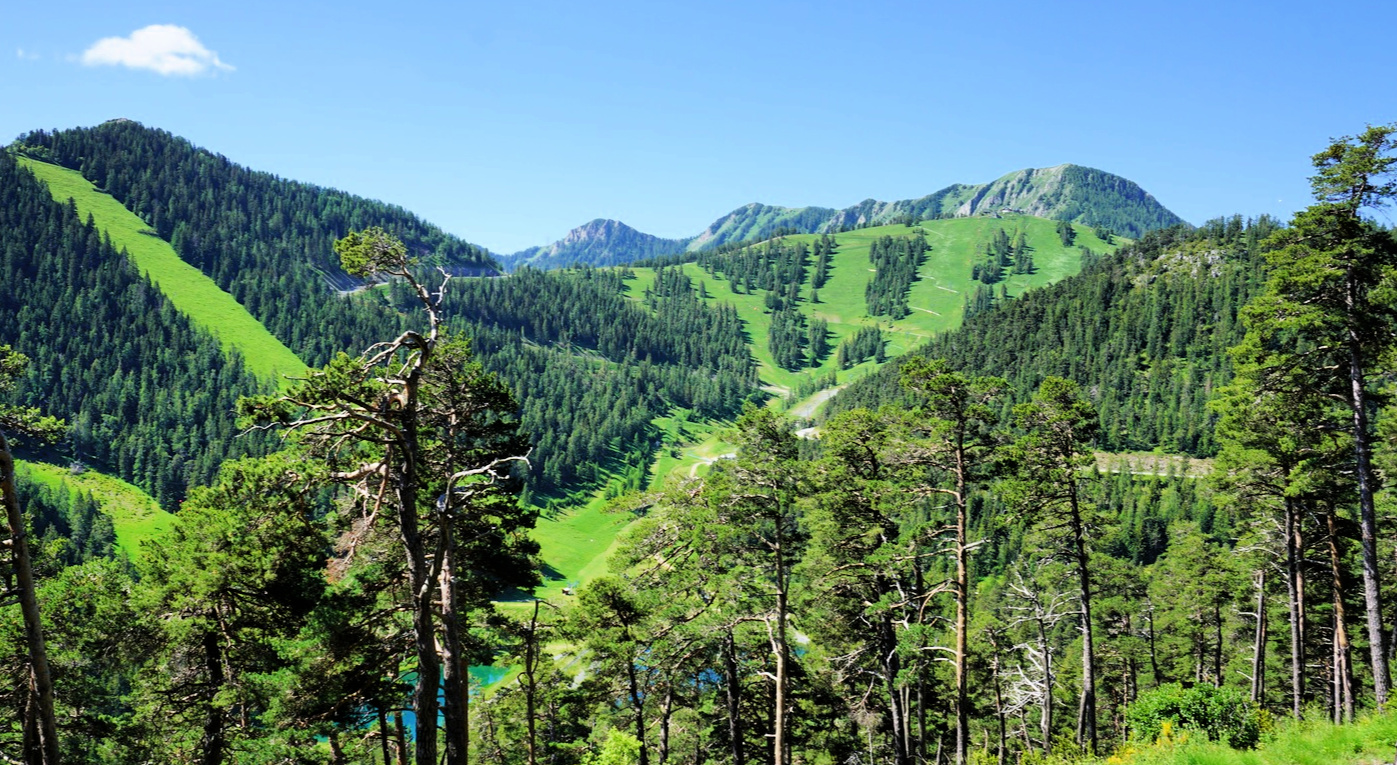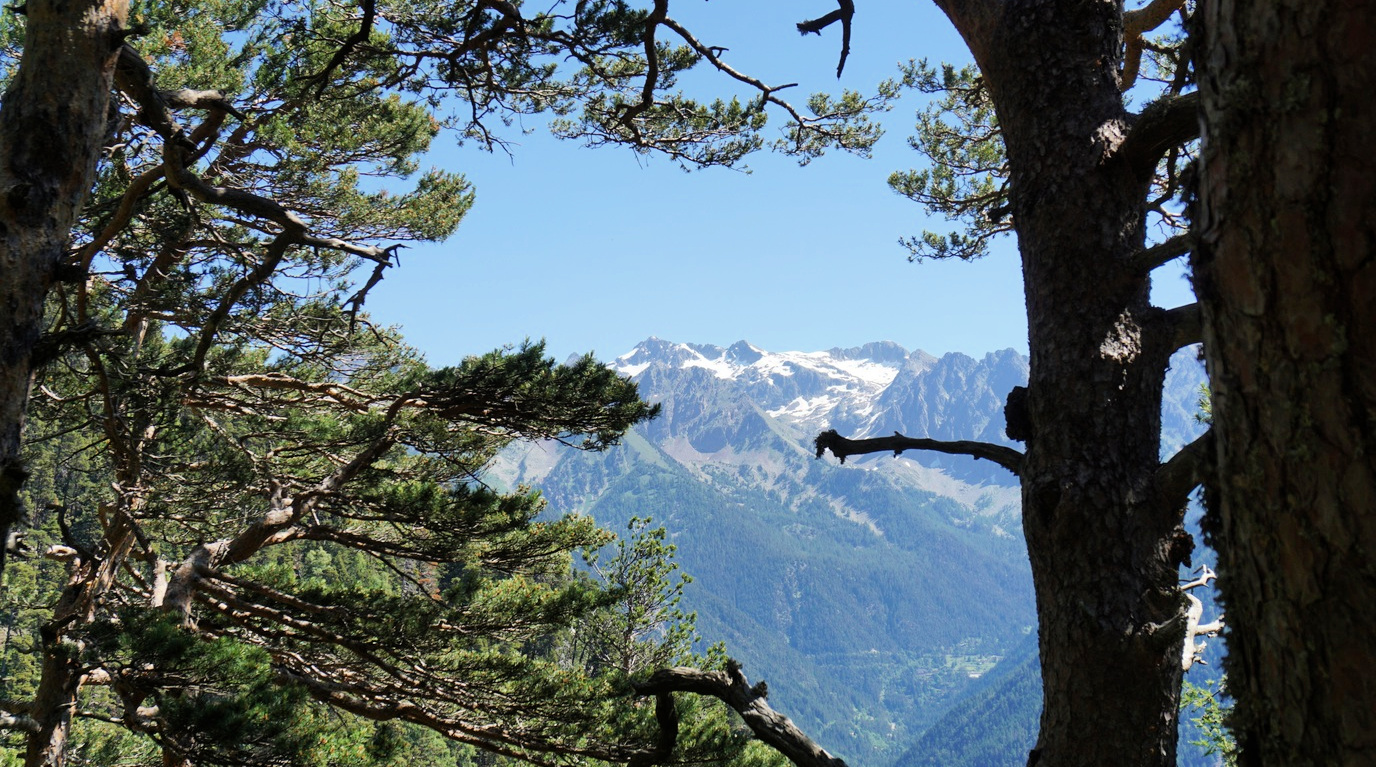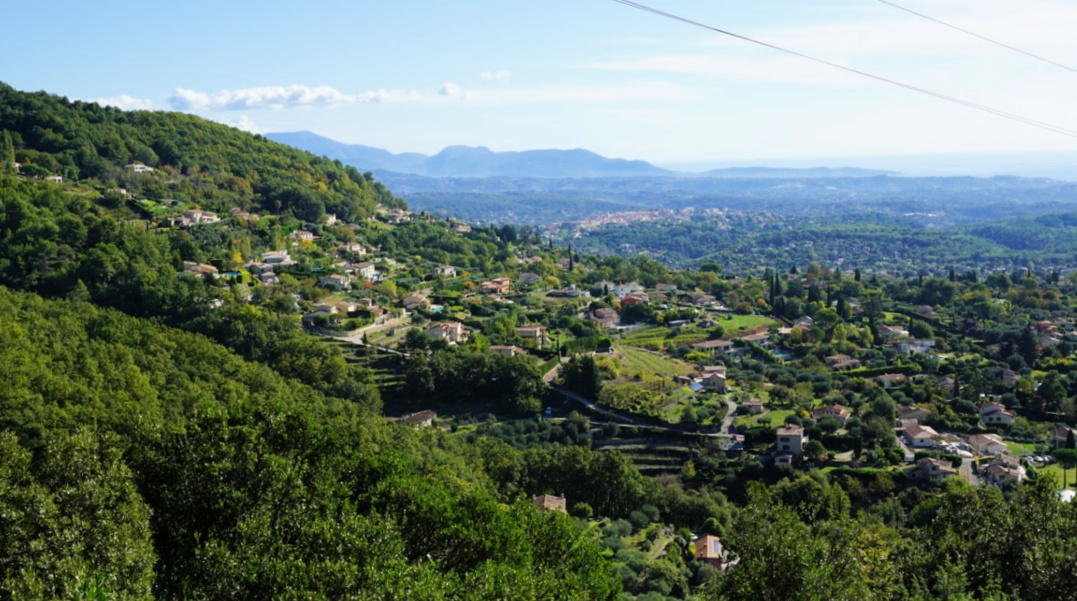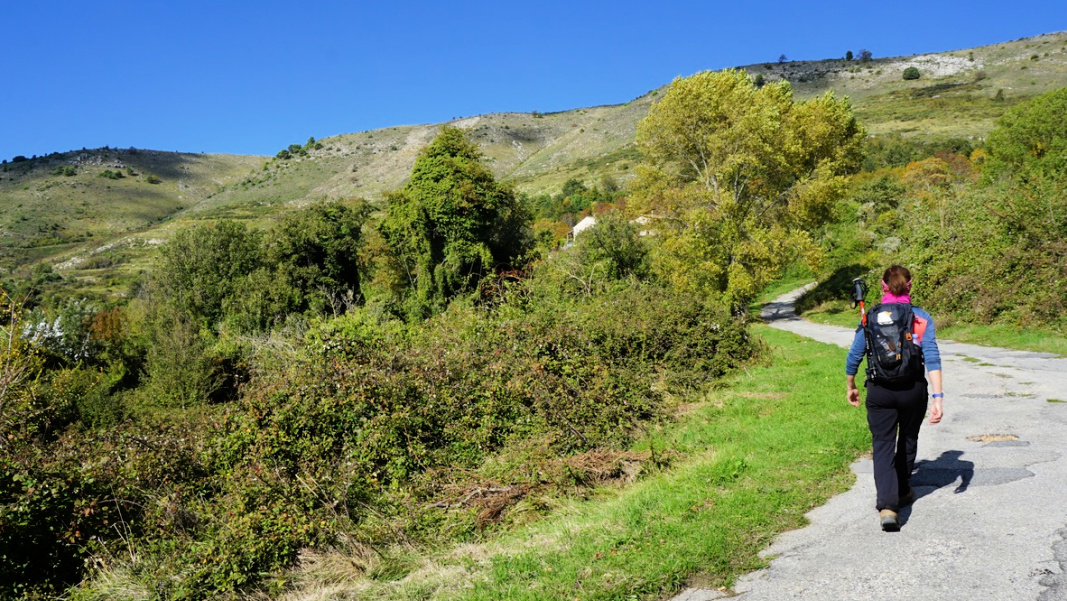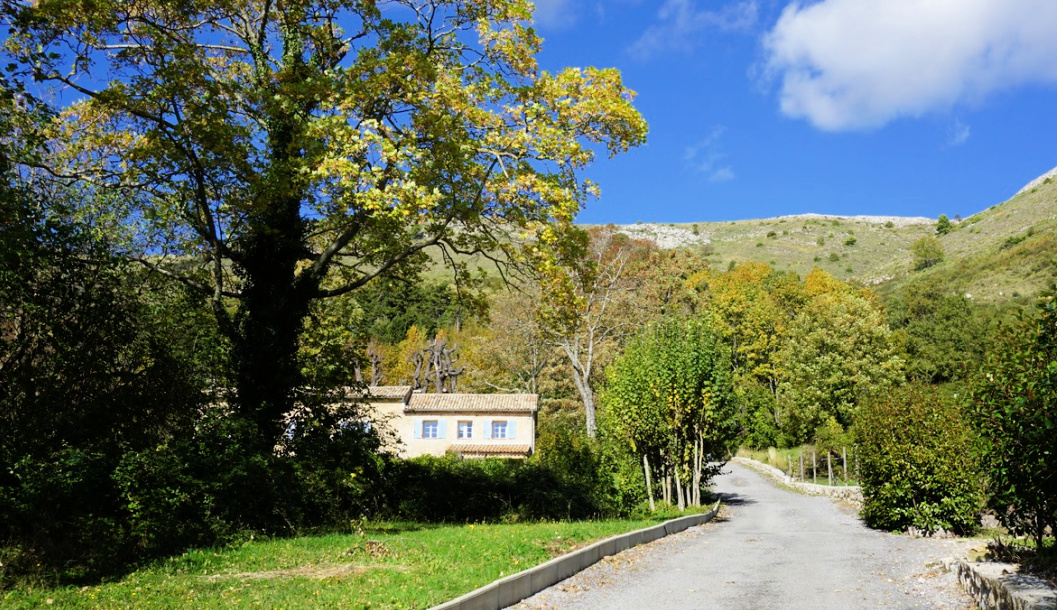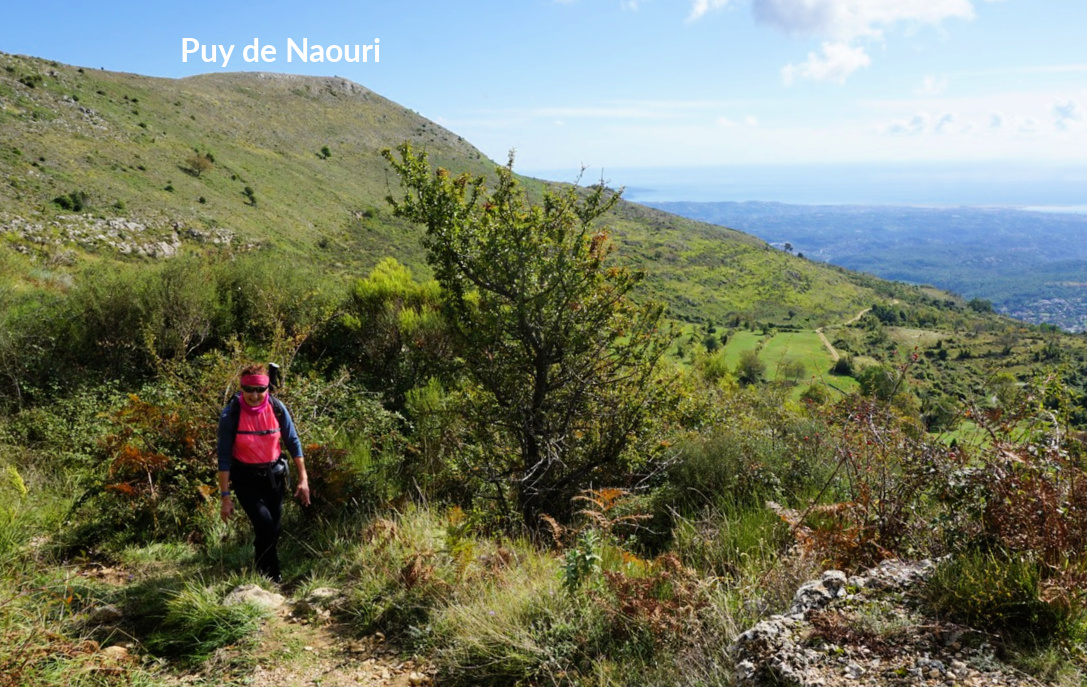Mont Viroulet (1864 m), as shown in the image above, has a forested northern flank and a quasi-bare and grassy southern face. Located above the Bramafam Valley (Valdeblore), the mountain can be easily reached from several points in the valley.
We chose to start from La Colmiane (1500 m) but the village of St-Dalmas Valdeblore (1290 m) is another popular option.
 |
| Peaks above Millefonts Lakes |
 |
| St-Dalmas Valdeblore |
 |
| At Col du Varaire |
 |
| Argentera seen from trail above Col du Varaire |
From La Colmiane, we hiked along the familiar trail to Col du Varaire (1710 m), passing signposts #94 and #98 where the trail merged with the GR5. We continued to Col de deux Caïres (1920 m) at the foot of Caïre Gros (2087 m). At the col, we forked right (west), and descended along a PR trail(yellow) to Col de la Madeleine (1736 m; signpost #97). We were at the foot of Mont Viroulet, and ascended along its partly forested eastern flank. The summit was actually a long ridge. We assumed that the highest point was marked with a large cairn partially hidden behind vegetation. We walked to the end of the ridge with great views to the west over the Tinée Valley as well as to the south.
We descended back to Col de la Madeleine where we forked left and descended further along a good and wide trail as far as to a dirt track. We headed east along it. The forest track ended near Col du Varaire but a path zigzagged the short remaining distance to the Col.
From Col du Varaire, we took the same trail back to La Colmiane.
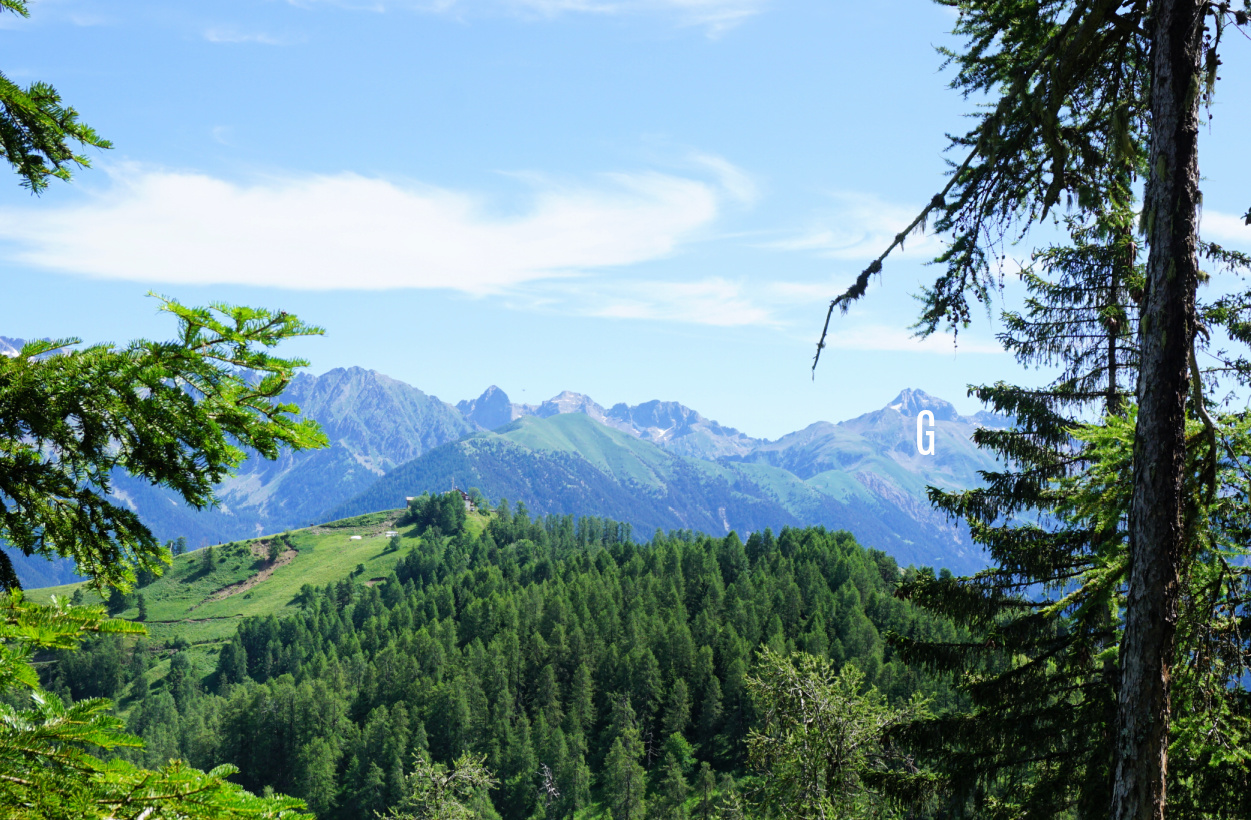 |
| Pic de la Colmiane and Gélas |
 |
| Near Col des Deux Caïres |
 |
| Near Col de la Madeleine |
 |
| Col de la Madeleine |
 |
| Caïre Gros seen from Col de la Madeleine |
 |
| View south from Col des deux Caïres |
 |
| Mont Viroulet summit |
Distance: 14 km
Climb: 680 m
Map: “Moyenne Tinée” 3641 ET
Here in Nice, we are lucky to be able to buy ready-made polenta in nice slices. You only need to reheat them for about 10 minutes in the oven and they make a nice side to many recipes.
If you cannot find ready-made polenta slices, cook it according to the advice on the package, pour into a tray about 1 cm thick layer and let cool in the fridge. Then slice it and warm as above.
2 servings
4- 6 nice polenta slices
1 organic courgette
1 organic red bell pepper
2 tbsp. black pitted olives, pref. organic Kalamata olives
2 eggs
For the pistou:
A bunch of organic basil
½ clove garlic, minced
Freshly ground black pepper
¼ tsp. salt
Olive oil
First make the pistou by crushing in a mortar with a pestle the basil leaves, garlic, salt, black pepper, and 2 tbsp. olive oil. Add more olive oil if needed to a nice consistence. Cover and keep refrigerated until needed.
Preheat the oven to 210° roast.
Cut the courgette into thin slices lengthwise and the bell pepper into nice pieces. Place 1 tbsp. olive oil in a plastic bag, add the bell pepper and shake. Pour in an oven tray and roast for 15 minutes. Meanwhile cook the eggs for 6 minutes. Peel and set aside.
Place the courgette slices in the same plastic bag and shake. Add to the oven tray, as well as the polenta slices. Continue roasting for 10 minutes.
Divide the polenta on the plates and add the courgette, bell pepper, and black olives. Place 1 egg in the middle and slice it. Drizzle with pistou and serve lukewarm.
This simple recipe is a great way to make fresh cod or other firm white fish more interesting.
2 servings
2 pieces of cod fillet, dos de cabillaud
Olive oil
½ medium onion, chopped
1 clove garlic, minced
2 handfuls of baby spinach leaves, pref. organic
2 tsp. Dijon mustard
Freshly ground black pepper
2 tbsp. dry bread crumbs
Warm 1 tbsp. olive oil over medium- low heat in a large saucepan and sauté the onion and garlic for about 10 minutes until soft but not browned. Add the baby spinach leaves and continue cooking until the spinach is wilted. Remove from heat and stir in the Dijon mustard and some black pepper.
Preheat the oven to 200° C, roast.
Lightly oil an oven- proof dish and place the cod in it. Cover with spinach mixture and sprinkle with bread crumbs. Drizzle 1 tsp. olive oil on top and transfer in the oven. Roast for 15- 20 minutes depending on the thickness of fish fillets.
Serve with new potatoes or blond lentils, roasted cherry tomatoes, and lemon wedges.
Aubergines and tomatoes are a classic combination. This dish has Eastern Mediterranean flavours from sumac, a delicious dark red spice from red berries of a Mediterranean shrub. In the Easter Mediterranean, sumac is sprinkled on warm pitas, grilled meats, and salads. In Nice, you’ll find sumac in well- stocked supermarkets.
Tomatoes concassées are easy to make: simply dip tomatoes in boiling water for a few minutes so that they are easy to peel.
Use this dish as a centre piece to your salads or serve as a first course.
2 servings
1 aubergine
2 tomatoes concassées
½ clove garlic, minced
Olive oil
1 tbsp. tomato paste
1 tsp. sumac
½ tsp. Piment d’Espelette or another mild chili powder
A pinch of salt (if sumac does not have added salt)
Preheat the oven to 180°C, roast.
Wash and dry the aubergine. Peel it and cut into about 1 cm thick slices. Lightly brush with olive oil and place on a baking tray. Roast 20 minutes until soft.
Meanwhile make the tomato compote. Warm 1 tbsp. olive oil in a saucepan over medium-low heat. Add the tomatoes concassées cut into chunks and the tomato paste. Add the garlic, sumac, and Piment d’Espelette. Cook until you get a nice compote.
Place the compote in a bowl and mix in the aubergine slices. Keep refrigerated until needed.
After the devastating storm named Alex in early October 2020, most of the trails in the Mercantour National Park and elsewhere in the northern part of Alpes Maritimes were closed.
On the other hand, many communes nearer the coast saw little or no damage. We designed a new variant from Tourrettes-sur-Loup (400 m), using mostly familiar paths from our previous hikes. We wanted do a circuit which includes the “twin peaks”: Puy de Tourrettes (1268 m) and Pic de Courmettes (1248 m). We have hiked up to them many times, but never ascended to both from Tourrettes-sur-Loup. We have instead used the village of Courmes (630 m) as our starting point.
From Tourrettes-sur-Loup, we started to ascend along the paved Route du Caïre. While not the most authentic route, it enables a rapid access to higher ground, and offers nice views.
We proceeded all the way to the end of the road, walked past le Caïre (850 m) and a guesthouse named Le Mas de la Source. We continued along the trail proper (indicating St Barnabé etc) behind the last houses and reached a crossroads at la Baïsse (1020 m). The marked trail continued north. Our trail to Puy de Tourrettes forked left (west). While not shown on maps, it is well visible and there are cairns here and there. We ascended along it diagonally along the south-eastern flank of the mountain.
We reached the summit plateau, and near the highest point forked left along a descending trail (still unmarked) which led to the saddle between the two peaks. Continuing straight south, we then climbed to Pic de Courmettes. The trail ran close to its the steep western face. Near the summit, we came to a marked trail which was our route back. We descended along the south-eastern flank first in open terrain, then in an oak forest.
We crossed to a dirt track not far from Domaine de Courmettes and turned left (north-east). We followed it about 2 km, as far as to signpost #179 where we forked right and descended to Route du Caïre (at signpost #174). Completing the loop, we followed the road back to Tourrettes-sur-Loup.
Map: Cannes Grasse Côte d’Azur 3643 ET



































